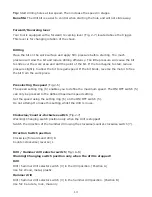
13
Forward/Reversing lever
Your tool is equipped with a forward/ reversing lever (Fig. 2-7) located above the trigger.
This lever is for changing rotation of the chuck.
Drilling
Place the bit on the work surface and apply firm pressure before starting. Too much
pressure will slow the bit and reduce drilling efficiency. Too little pressure will cause the bit
to slide over the work area and dull the point of the bit. If the tool begins to stall, reduce
pressure slightly to allow the bit to regain speed. If the bit binds, reverse the motor to free
the bit from the work piece.
Preselecting the speed
(Fig.2-6)
The speed setting ring (6) enables you to define the maximum speed. The ON/OFF switch (5)
can only be pressed to the defined maximum speed setting.
Set the speed using the setting ring (6) on the ON/OFF switch (5).
Do not attempt to make this setting whilst the drill is in use.
Clockwise/Counter-clockwise switch (Fig.2-7)
Warning! Changing switch position only when the drill is stopped!
Switch the direction of the hammer drill using the clockwise/counter-clockwise switch (7).
Direction Switch position
Clockwise (forwards and drill) R
Counter-clockwise (reverse) L
Drill / Hammer drill selector switch (Fig.3 A-B)
Warning! Changing switch position only when the drill is stopped!
Drill
Drill / hammer drill selector switch (3) in the drill position. (Position A)
Use for: Wood, metal, plastic.
Hammer drill
Drill / hammer drill selector switch (3) in the hammer drill position. (Position B)
Use for: Concrete, rock, masonry
Tip: Start drilling holes at low speed. Then increase the speed in stages.
Benefits: The drill bit is easier to control when starting the hole and will not slide away.




































